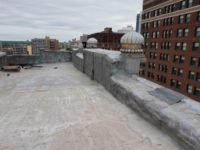
When you think of commercial buildings in midtown Manhattan, green space isn’t the first thing that comes to mind. However, that might be changing. When it came time to replace the roof on the United States Postal Service (USPS) Morgan Mail Processing and Distribution Center on Ninth Avenue in New York, a vegetative roof was at the top of the wish list.
Built in 1933, the building is designated a historical landmark. It’s also as big as a city block and serves as a major mail sorting facility that operates 24 hours a day. When the existing built-up asphalt roof began to fail, the USPS looked at options to reduce energy usage as part of its goal to reduce energy use by 30 percent by 2015. The objective was to incorporate a garden roof without busting the budget and recycle or reuse as much of the material as possible - all without disrupting normal operations at the facility.
Working closely with the USPS, the construction and design teams from Turner Construction, URS Corp., EKLA landscape architects, and Tecta America’s JP Patti Roofing and Magco units installed nearly 2.5 acres of green roof as part of the 109,000-square-foot overall roofing project. The project was completed on time, under budget, and without interrupting the facility’s operation. The result is a complete transformation of the site and the largest green roof in New York City.

The Roof System
Roofing Contractor spoke with Gordon Hastings and Angie Durhman of Tecta America to get their firsthand perspective on the project. Hastings, Chief Estimator for JP Patti Co Inc. A Tecta America Company, Saddle Brook, N.J., has been with the company more than 25 years. Durhman, Green Roof Manager for Tecta America, works with all of Tecta’s operating units on green roof projects. They were involved with the roofing phase of the project from start to finish.
The new roof system consists of Sika Sarnafil 80-mil PVC loose laid membrane installed over 1/4-inch DensDeck board and 3 inches of extruded polystyrene insulation. Approximately 33,600 square feet of the roof surface is covered with river washed gravel applied over a Sika Sarnafil protection sheet. Concrete pavers cover another 12,700 square feet. Some 63,000 square feet was covered with a protection sheet, drainage mat, separation fabric, water retention mat and growth media. Most of the garden roof area had 4 inches of growth media, but some areas received 8 inches of growth media to form berms. A variety of plants were installed, and nine trees were placed in a planter along the center of the roof.
The existing built-up asphalt roof remained in place, according to Hastings. The loose aggregate was removed by Adler Roof-Vac and used to fill a parking lot in New Jersey. An infrared scan detected some wet insulation, and five areas of insulation were replaced with new insulation to match the height of the existing roof.

A Challenging Site
The bustling distribution center and midtown Manhattan location posed some construction challenges. “The post office is a 24-hour operation,” said Hastings. “We could only set up on one corner of the building because all these loading dock doors were active.”
The space for loading and unloading was very tight. “Pre-planning was extremely important on this project as the building is located at the exit of the Lincoln Tunnel, a major traffic route into New York City from New Jersey,” Hastings said. “Traffic lanes could not be blocked for loading materials or removing debris except for Saturday and Sunday, and then only one lane of the three-lane road could be blocked. This resulted in the crane having to set up close to the building and did not leave much room to swing over the parapet wall onto the 130-foot-high roof. Coordinating truckload deliveries of materials for loading at the weekend was critical so roofing could be installed during the following week.”
The crane was set up on one lane of the road and the sidewalk, and tractor trailers pulled up in the blocked-off lane to have the material unloaded. The crane’s range was limited and material had to be dropped near the edge of the roof, just over the parapet walls. “They could only put it right over the roof edge because they had to be so close to the building,” he said. “They couldn’t put it in the center of the roof. We had to buggy it over to the areas we were installing.”
The new loose laid roof system was installed in accordance with the membrane manufacturer’s specifications and flood tested prior to installing the soil, overburden and gravel ballast, Hastings explained. RK Hydrovac blew the growth media up onto the roof. “The growth media or soil was pumped up from ground level and across the roof a maximum distance of 300 feet, and the plants and trees were then installed.”
The existing concrete pavers were reused on a higher roof, and the historic look of the building was retained by restoring some original copper elements. “When the building was originally built, they extended the vertical steel columns through the roof about 3 feet,” Hastings said. “Apparently there were plans to add more stories later.”
The columns were capped with distinctive copper covers that had developed a beautiful green patina. “The intention was to maintain the rustic look and the old covers with the patina were re-used,” Hastings said.

The Living Roof
With a background in horticulture, Durhman works with Tecta America contractors all over the country. “As Green Roof Manager, I take care of the overburden for these living roofs,” she said. “I work on the design, project estimating, actual project management, and maintenance.”
The original scope called for 12 inches to 18 inches of soil, but it was reduced to the 4 inch and 8 inch soil profiles to fit the project’s budget.
Plants were chosen that would thrive in the local environment, including sedum, drought-tolerant grasses, and perennial flowers, including coreopsis. Serviceberry trees were placed in a planter in the center of the roof. Plants were irrigated during the establishment period, but there is no permanent irrigation system. The plugs grew in quickly. “Within about eight months we had 80 percent coverage,” she said.
Coordinating the delivery of the plants was crucial, noted Durhman. “As soon as they were taken off the truck they were craned up within the hour and planted that same day.”
Tecta America’s services include a two-year maintenance agreement. “We are maintaining the roof to eliminate any weed presence, in case random grasses or weeds are dropped on or blown on the roof,” Durhman said. “We make sure plant health is good.”
The company prides itself on handling all phases of green roof projects, and Durhman noted the single source for warranty work is an added selling point.
“We have experienced crews who do the planting,” she said. “Everything is done in-house, including the maintenance. We consider it part of roofing work.
A Touch of Green
Everything went according to plan, said Hastings. “It did go smoothly, considering the difficulties of loading and unloading,” he concluded. “When you have good people on the job, it goes smoothly.”
The roof is estimated to last 50 years, minimize storm water runoff and save an estimated $30,000 a year in heating and cooling costs. The improved aesthetics are the icing on the cake.
“I think if you took a snapshot of Manhattan, there are a lot of unusable roofs for green applications - too small, too much equipment, etc.,” Durhman said. “I’d like to recognize the post office for realizing that the roof posed a great opportunity for green space. Open roofs - there aren’t a lot of them in Manhattan, but we want owners to consider them for green projects as well.”




